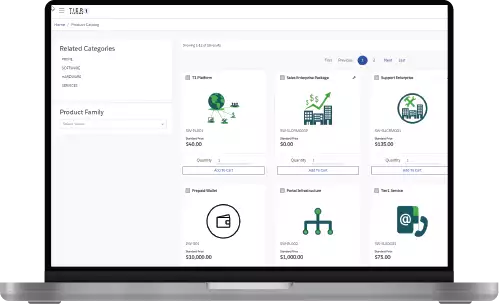
How CPQ can help drive sales
Free eBook
Conga CPQ: the key to unlocking predictable revenue
For organizations looking to gain insights into their revenue lifecycle, a configure, price, quote (CPQ) system can create streamlined, automated processes that minimize manual errors, improve communication between teams, and optimize the customer experience.
A CPQ solution is critical for driving more sales, because today’s enterprise deal-making requires complex configurations and unique pricing rules—often on a massive scale. It also helps to maximize revenue by improving selling practices, increasing average deal size, and boosting win rates across the board.
All these benefits provided by a CPQ solution can set an organization up with one of the most sought-after superpowers in business-to-business (B2B) sales—predictable revenue. CPQ solution suites are among the fastest-growing B2B sales applications on the market for businesses looking to align their operations with their revenue growth goals.
Understanding your revenue lifecycle
A predictable revenue model relies on your organization’s ability to predict outcomes and understand its revenue lifecycle. For example:
- What’s your average deal size?
- What did you sell?
- How fast did you sell it?
- Which industries purchased what product?
- What was discounted?
- How much was discounted?
- What industries were discounted and at what rates?
- What price point is most successful?
- What discounts are more successful?
If you don’t have the answers to these questions, the best route to predictable revenue is a CPQ solution suite that can deliver results and provide answers within your revenue lifecycle.
What does predictable revenue look like?
A predictable revenue model is a framework that estimates how much revenue your business is constantly generating, showing how the business will grow. This means understanding how much average revenue the company makes over time, in order to see how you can improve certain areas in the future. There is no room for last-minute guessing.
Why predictable revenue is important
Without predictable revenue, a company’s future is always uncertain. One-time revenue spikes that aren’t repeatable won’t help you achieve consistent year-over-year growth, leaving the destiny of your organization up to chance. Outside influences such as hiccups in the economy, regulation changes, new competition, or the loss of a major customer can put your organization at risk if not planned for. With a proper CPQ tool, you can:
- Set revenue targets each year and achieve them within a narrow margin of error.
- Determine that each year’s growth rate will increase by a specific percentage, continually stretching capabilities.
- Create consistency for customers with steady pricing at different points of engagement.
Barriers to predictable revenue
If you are having challenges within your revenue lifecycle, they can be difficult to scale past. Some of the challenges that block predictable revenue include:
- Excessive deal cycle times created from slow quoting and approval times
- Manual errors because products are highly configurable
- Deal mistakes or configuring products that don’t work together
- Out-of-date product or pricing information
- Missed cross-selling or upselling opportunities
- The same deal configurations are sold over and over
- Lack of visibility into the sales process
- Over discounting to close deals quickly, eroding margins
If you’re having any of these problems, the best path to predictable revenue is a CPQ solution.
CPQ breakdown
When you understand the growth trajectory of your business, you can comfortably take on investments like additional employees, systems, tools, and investments in products. But you need to know what margins you’re working with—that’s what CPQ is for.
CPQ is a tool that not only enforces processes to solve business challenges, but also serves as a foundation for a more predictive business model. It creates a repository of configurations and discounts that can be tied to deal attributes, like competitors, segments, industry, deal size, and win/loss data. With CPQ you can start surfacing the characteristics of historically successful deals, position complementary products, and optimize discount levels with recommendations at quote time for your in-flight opportunities. These outcomes can maximize revenue, margin, or a combination of the two.
Configure: A configuration engine contains predefined rules that will guide the user through any required configurations and offer insights into optional components of additional services for cross-sell or upsell opportunities. Accurate and optimized product configurations help you achieve predictable revenue by:
- Avoiding delays because products are configured correctly, creating consistent time to revenue
- Maximizing deal size with the appropriate cross-sells and upsells
- Determining what bundles work best and making them standard
Price: Pricing enables the management of complex pricing structures and logic, as well as promotions and discounts. Utilizing an advanced pricing engine, users can define multiple price types, like one-time, recurring, or cancellation, for any product. Also, dimensional or formula pricing can be defined based on quantity, customer rating, and region. As you accumulate transactional data you can build models to optimize your revenue, including:
- The best opening offer based on company size or industry
- The discount with the best rate of success without eroding the margin
- Pricing deals in a way that they are most likely to close upsells
When you start to leverage the data to optimize revenue, it’s a win for the sales rep, an operational win for the extended team, and a win for the bottom line.
Quote: For complex quotes that require participation from multiple people within the organization, CPQ provides the tools to send the whole quote or portions of it to specific team members or groups. They can help configure and price the quote, allowing various contributors to work in parallel, expediting the quote, without compromising on quality. A smooth quoting process enables predictable revenue by:
- Generating faster quote turnaround time which accelerates time to revenue
- Creating predictability in deal timelines
- Ensuring more accurate quotes that don’t slow time to revenue
How CPQ can help drive sales
Today’s customers expect a quick, convenient buying experience—but behind the scenes, sellers are often faced with a complex, multi-layered quote-to-cash process. A robust CPQ solution—like Conga CPQ—streamlines and automates this process, so sales teams can improve performance and close more deals—faster. Here’s how:
- Centralized data. CPQ puts current, accurate data at sellers’ fingertips—including product catalogs, bundling options, pricing information, discount rules, renewal terms, and more.
- Consistent selling practices: A CPQ solution can build workflows that mimic the practices of your top sellers, to improve sales team performance and drive greater consistency across your business.
- Increased productivity. CPQ technology eliminates manual processes, so sales reps can build and deliver customized quotes in minutes—no matter how complex your product offerings or price structures.
How CPQ can help increase revenue
In today’s complex market, business success is never guaranteed, but your chances improve if you can find ways to drive more revenue. CPQ technology—like Conga CPQ—lets you take control of the end-to-end revenue process, so your sales team can increase both win rate and deal size. Here’s how:
- Eliminate quoting errors. Manual quoting processes are slow and error-prone—which can frustrate customers and drive them to your competitors. CPQ automates the process so customers receive personalized quotes that are quick and accurate.
- Control rogue discounting. Stop worrying about inconsistent pricing and unauthorized discounts that eat into profits. A CPQ solution generates full-spectrum quotes from a single, centralized source of data so pricing and discounts are always reliable and up to date.
- Maximize lifetime deal value. Missed cross-sell and upsell opportunities are among the biggest sources of lost revenue. CPQ uses previous order data to make additional purchase recommendations, so sales reps can make the most of every deal.
Business outcomes of predictable revenue through CPQ
With the right CPQ tool, you can expect a better understanding of your pipeline and higher forecast accuracy. With CPQ, get the data you need to set meaningful, achievable targets for product-specific pipelines and bookings. Some additional benefits are:
- Optimized deal structures based on revenue or margins
- Reduced SKU proliferation
- Improved transaction velocity
- The ability to anticipate problems with enough time to course-correct
- Tailored customer engagement based on previous interactions and purchase history
- Predictable billing and payments, helping the business’s cashflow and customer experience
- Streamlined renewals
Overcoming the status quo
While change can be difficult, disjointed processes can be costly. Without predictability, the customer’s experience suffers, employees can’t sell efficiently, and money is left on the table. Once broken processes are addressed and a CPQ tool is implemented:
- Deals could be 22% bigger
- Win rates could be 30% better
- Sales revenue could be 25% stronger
Creating organizational buy-in for CPQ
It’s clear—CPQ can change the way you do business and unlock a predictable revenue model. But the end goal can get convoluted if you don’t have strong organizational buy-in.
The best route to organizational buy-in is to have a clear implementation roadmap. If all the steps and benefits of CPQ are clearly laid out, then it will be easy to set expectations, secure buy-in from all the teams participating, and make a case to build out team structures where necessary.
The first step on the road to a successful implementation is to identify the essential business objectives and goals behind your CPQ system integration. What are you trying to achieve? What’s the vision? This will guide the rest of the project and create stakeholder alignment. Common goals include:
- Accelerate quote delivery time
- Increase order size
- Free up sales reps’ time to sell more
- Improve quote accuracy
- Boost win and renewal rates
- Reduce churn
Once goals are set, talk to your stakeholders to determine their biggest pain points. A great place to start is to identify existing bottlenecks, inefficiencies, and backlogs where teams are struggling. Discovery conversations like these can ensure CPQ eliminates the biggest issues within your organization. When the right conversations take place, everyone feels invested—so they can better appreciate the benefits and ultimately get on board.
From there, map out your quote-to-cash process and see what can be automated to alleviate pain points. Check out our implementation quick guide to learn more about how to do this and what comes next.
Quick tip: You can also leverage customer stories as part of the roadmap process. There is nothing like real-world proof of value to secure organizational buy-in.
A CPQ solution for your revenue lifecycle
A great CPQ solution creates a consistent customer experience, streamlines the sales experience, shortens the sales cycle, and makes for a satisfied buyer. It addresses the daily challenges faced by your sales representatives and automates processes to provide configuration solutions.
Once you understand your business functions and sales organization needs, you can use tailored features such as guided selling, automated approval process, and proposal generation to ensure that products move through your sales cycle faster than ever before. Having a predictable revenue model by way of a CPQ tool means consistency—internally within your organization and for your customers.
Get started with Conga CPQ

Does CPQ sound like it could help solve the challenges that are blocking you from predictable revenue growth? Learn more about everything a CPQ tool can do by checking out our ultimate guide to CPQ—then get a demo to see Conga CPQ in action.
Free eBook



